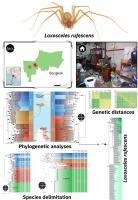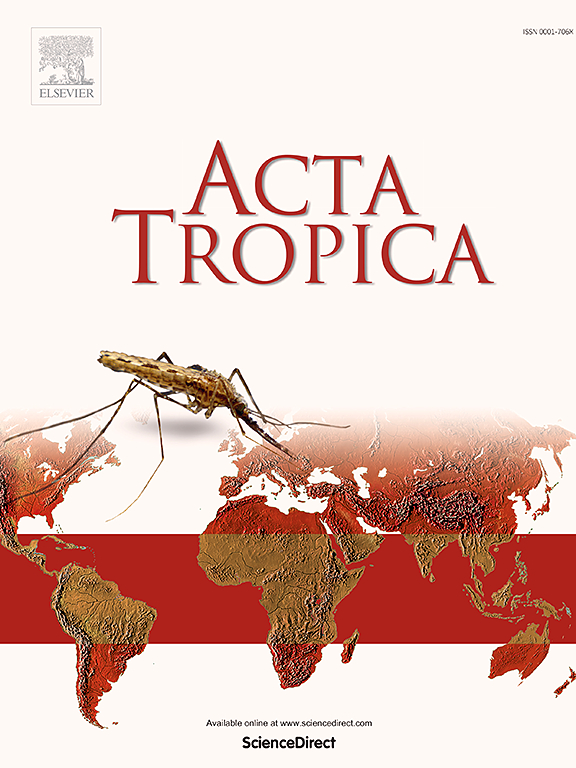Phylogenetics and species delimitation of the recluse spider, Loxosceles rufescens (Araneae: Sicariidae) populations invading Bangkok, Thailand
IF 2.5
3区 医学
Q2 PARASITOLOGY
引用次数: 0
Abstract
The Mediterranean recluse spider, Loxosceles rufescens, has been discovered for the first time inhabiting human dwellings in Bangkok, Thailand. Expeditions across 39 localities revealed five establishments with L. rufescens populations. The highest density was recorded in a storage house on Yaowarat Road, located in the heart of Bangkok's Chinatown, where 315 individuals were found, including adults, juveniles, and spiderlings. This medically significant spider's presence in such a densely populated urban area raises concerns about potential envenomation risks. Thirteen specimens of L. rufescens were extracted for DNA and sequenced for molecular phylogenetic analyses. COI and ITS2 markers were used to investigate relationships within L. rufescens and across available Loxosceles species sequences. Results indicate COI is superior for resolving species-level genetic clusters compared to ITS2. Surprisingly, L. rufescens individuals from the same house were found in significantly distant COI lineages, suggesting mtDNA may not be suitable for studying intra-specific phylogeography in this case. Species delimitation methods ABGD and ASAP demonstrated promising results for both COI and ITS2, while bPTP and GMYC tended to overestimate species numbers. ITS2 exhibited high sequence similarity in L. rufescens, suggesting potential utility as a barcoding marker for identification of this globally distributed species. Genetic distance analyses revealed a potential barcoding gap (K2P) of 8–9 % for COI and <2 % for ITS2 in Loxosceles. This study contributes valuable sequence data for the medically important genus Loxosceles and highlights the need for integrative approaches in understanding its evolution and spread. The findings have important implications for pest management strategies and public health in urban environments.

入侵泰国曼谷的疣蛛 Loxosceles rufescens (Araneae: Sicariidae) 种群的系统发育和物种划分。
在泰国曼谷的人类住宅中首次发现了地中海隐蛛(Loxosceles rufescens)。在对 39 个地点的考察中,发现了五处有 L. rufescens 种群的场所。密度最高的是位于曼谷唐人街中心的 Yaowarat 路的一个仓库,共发现 315 只,包括成蛛、幼蛛和幼蛛。这种在医学上具有重要意义的蜘蛛出现在人口如此密集的城市地区,引起了人们对潜在毒杀风险的关注。我们提取了 13 个 L. rufescens 标本的 DNA,并对其进行了分子系统学分析测序。COI 和 ITS2 标记用于研究 L. rufescens 内部的关系以及现有 Loxosceles 物种序列之间的关系。结果表明,与 ITS2 相比,COI 在解析物种级遗传集群方面更具优势。令人惊讶的是,来自同一住宅的 L. rufescens个体被发现在明显不同的 COI 系中,这表明 mtDNA 在这种情况下可能不适合研究种内系统地理学。ABGD和ASAP方法在COI和ITS2方面都显示出良好的结果,而bPTP和GMYC则倾向于高估物种数量。ITS2 在 L. rufescens 中表现出很高的序列相似性,表明它有可能成为鉴定这一全球分布物种的条形码标记。遗传距离分析表明,COI 和 GMYC 的潜在条形码差距(K2P)为 8-9%。
本文章由计算机程序翻译,如有差异,请以英文原文为准。
求助全文
约1分钟内获得全文
求助全文
来源期刊

Acta tropica
医学-寄生虫学
CiteScore
5.40
自引率
11.10%
发文量
383
审稿时长
37 days
期刊介绍:
Acta Tropica, is an international journal on infectious diseases that covers public health sciences and biomedical research with particular emphasis on topics relevant to human and animal health in the tropics and the subtropics.
 求助内容:
求助内容: 应助结果提醒方式:
应助结果提醒方式:


